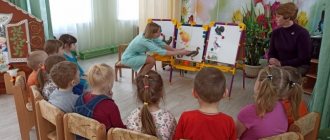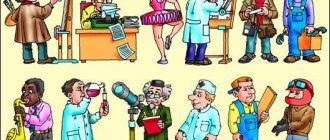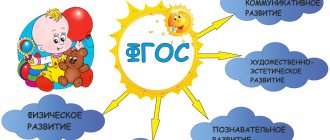Logorhythmics in the correction of rhinolalia
Victoria Smertina
Logorhythmics in the correction of rhinolalia
In these classes, using logorhythmics, you should develop : 1) facial expressions; 2) general motor skills: tone of movements, coordination, switchability; 3) mobility of the velum; 4) speech motor skills; 5) overcome nasalization.
To develop facial expressions, already known situations are used: “We are eating lemon”
etc., outdoor games with appropriate text.
"We are funny guys"
.
In the middle of the room, two parallel lines are drawn with chalk at a distance of 15-20 steps from each other (the driver is here)
. There are children behind the line, and at a musical signal they cheerfully and cheerfully say: “We are funny guys, we love to run beyond the opposite line. The driver tries to catch up with them and touch them within his zone. Those whom it touches leave the game, sit on chairs, rest and perform various breathing exercises to differentiate nasal and mouth breathing: blowing on fluff, leaves, etc. After 3-4 runs from one line to another at the teacher’s signal a new driver is appointed from among those who have rested.
To develop general motor skills, games are played to switch movements.
"Don't knock it down and catch it"
.
Children must overcome several obstacles. The first is a jump rope stretched at a height of 60 cm from the floor, then 1 m from it - a jump rope at a height of 40 cm from the floor, after 1 m - the next jump rope at a height of 5 cm. to different types of music, children take turns passing the first obstacle with a “bear”
, i.e. on half-bent legs, arms apart;
the second they crawl with a “mouse”
, i.e. they crawl on their stomachs until the third obstacle;
stand up, jump over it and squat “frog”
, i.e. get on all fours.
After this, the player must straighten up, catch the ball or hoop thrown by the speech therapist , and step aside with it. As all the children overcome the obstacles, at the speech therapist’s “play!”
they play with a ball or hoop.
To activate the velum palatine, exercises should be carried out with imitation of coughing, yawning, swallowing, playing with singing and using songs. The lyrics of songs must be rich in vowel sounds. While singing, the teacher monitors breathing, diction, and a sufficiently wide opening of the mouth of the students. Singing can be used to relieve nasalization in speech. You should start by singing vowel sounds in significant situations. For example, children follow the music to the rhythm of a moving train, stop, blow the horn: “Uuu!”
Or the teacher shows various pictures, the children react to them with an exclamation;
for example, they see a round, red tomato and sing: “Oooh!”
walk through the forest and call out to each other:
“Ay – au – au!”
They depict a crying girl:
“Wa – wa – wa!”
A wolf is depicted using onomatopoeia:
“Uh!”
;donkey:
“Eeyore!”
;
dog; "Aw!"
;
cat; "Meow!"
etc. It is useful to combine singing with movements.
Logorhythmic classes with patients with rhinolalia are structured in such a way that all types of work have a positive effect only on speech function, but also have a general strengthening effect. Classes begin with cheerful march music. Children walk: their heads are raised, their shoulders are turned. The step is accompanied by energetic swings of the arms. Children show different types of walking. In agreement with the speech therapist, you can recite poems while walking in time with your steps.
The main part of the lesson includes a set of movements united by one topic. For example:
“Bubble”
(for preschoolers and schoolchildren)
.
Children stand in a circle to the music. The teacher says: “Blow a bubble
.
Children inflate their cheeks, like a bubble, and say: “Fu-u
,” holding hands, they walk from the center with their backs, forming a large circle. Teacher:
“The bubble has burst
.
Repeat the first movement again. At the signal “the bubbles flew! Children puff out their cheeks and, holding them in this position, move in a circle, rounding their arms in front of them. Then they stop and, while listening to the music, line up in a circle that bursts. Children drop their hands along their torsos, then everyone sits on chairs and sings the song “Soap Bubbles” (music by Kühn)
.
The lesson ends with walking to calm music. You can include the game “Train”
. The wheels of the locomotive are knocking, the levers are working - the arm is bent at the elbow joints; wheels are checked. The train has started, they are letting off steam, blowing the whistle, etc.
"Geese"
.
Geese (children)
flap their wings, peck, hiss, cackle, fly, etc.
"Aircraft"
. Children, imitating checking gas pumps, pronounce - sss, engine - rrr. The planes took off, arrived, landing, pilots.
Articulatory exercises for the development of speech motor skills with patients with rhinolalia are carried out in the same way as with children with functional dyslalia. On the advice of a speech therapist , the music director includes in his lesson preparatory articulatory and staging exercises necessary for the formation of a certain articulatory structure.
At the stage of sound differentiation, dramatization games with and without musical accompaniment are useful. The text of the game is saturated with distinguishable sounds. The introduction of characters enriches the prosody of speech.
In the process of logorhythmic work, general motor skills, speech and voluntary behavior in activities (play, study, communication) are normalized in children with dyslalia.
The speech therapist includes speech material with oppositional sounds.
Musical and rhythmic classes for people suffering from rhinolalia
The goal and objectives of logorhythmics are to develop facial expressions, as well as general motor skills - movement tone, coordination, switchability; mobility of the velum; speech motor skills; overcome nasalization.
To develop facial expressions, well-known situations are used: “We are eating lemon”, “Sweet jam”, “Bitter pepper”, “A long-awaited gift”, “The doll is sick”, “Mom has come”, “I want ice cream”, etc. Outdoor games with appropriate text are used.
"We're fun guys."
In the middle of the room, two parallel lines are drawn with chalk at a distance of 15-20 steps from each other (the driver is here). Children are standing behind the line; at the sound of a musical signal, they cheerfully say: “We are cheerful guys, we love to run and play. Well, try to catch up with us!”: The children run across the opposite line laughing. The driver tries to catch up with them and touch them within his zone. Those whom it touches leave the game, sit on chairs, rest and perform various breathing exercises to differentiate between nasal and mouth breathing (blowing fluff, leaves, etc.). After 3-4 runs from one line to another, at a signal from the teacher, a new driver is appointed from among those who have rested.
Games for developing gross motor skills
“Don’t knock it down and catch it.”
Children must overcome several obstacles (jump ropes). One rope is stretched at a height of 60 cm from the floor, the other is 1 m from it, at a height of 40 cm from the floor, after 1 m - the next rope is at a height of 5 cm. To the music of different characters, children take turns passing the first obstacle with a “bear” gait. , i.e. on half-bent legs, arms spread and rounded; the second is crawled with a “mouse”, i.e. crawl on their stomachs until the third obstacle; stand up, jump over it and squat “frog”, i.e. get on all fours. After this, the player must straighten up, catch the ball or hoop thrown by the speech therapist, and step aside with it. When all the children have overcome the obstacles, at the speech therapist’s signal: “Play!” start playing ball or hoop.
Speech therapy work for rhinolalia
Speech therapy work with children suffering from rhinolalia begins at 2-3 years of age and is carried out both in the preoperative and postoperative periods. If we keep in mind only rhinolalia (without taking into account the possible general underdevelopment of speech that accompanies it), then the ultimate goal of speech therapy work is to remove the nasal tone of the voice and develop correct sound pronunciation, which will ultimately ensure the normalization of the child’s speech function. However, neither one nor the other can be achieved without providing the necessary prerequisites. These include the development of mobility of the soft palate, the development of a sufficiently strong and prolonged oral exhalation, and the achievement of a forward position of the tongue. The creation of these prerequisites begins already in the preoperative period.
The main goal of preoperative speech therapy and a set of therapeutic measures is to prevent as much as possible those possible deviations in the development of the child, which are, as it were, predetermined, programmed by the very fact of the presence of a cleft, and also to prepare more favorable conditions for the operation. During this period, the main attention should be paid to the following.
1. Prevention of the appearance of asthenic syndrome. Since it is known in advance that children with congenital cleft palates are weakened and predisposed to colds, from a very early age it is necessary to take care of hardening the child and stimulating his physical development. Hardening is carried out from the very first months of life. For this purpose, you can use air baths, water procedures, and walks with the child in the air that gradually increase in duration, provided that their duration is gradually increased and the temperature does not fluctuate too sharply.
Stimulation of physical development is achieved mainly through outdoor games and special physical exercises. At the earliest stages of development, it is best to “follow” the course of normal ontogenesis, somewhat activating those movements that are available to a child of a given age. For example, if in the period from 6 to 10 months the child mainly crawls, then attention is focused on intensifying crawling. To stimulate this motor process, the child is asked to crawl either to his mother, or to his father, or to his grandmother, or for a bright toy. The distance can be gradually increased. At the appropriate age, approximately the same thing is done with walking and running. Hide and seek, ball and other outdoor games are used.
2. Prevention of tongue fixation in the wrong position. For this purpose, from the very first days of his life, they avoid placing the baby on his back, so that this position itself does not provoke the tongue to sink back. In the future, they try in every possible way to stimulate the movements of the tip and the front part of the back of the tongue (for example, you can systematically invite the child to lick jam from the upper lip, “brush teeth” with the tip of the tongue, play “clock”, moving the tongue sticking out of the mouth from one corner of the mouth to another and etc.).
The anterior position of the tongue is very important for educating the child already in the preoperative period of oral exhalation, since the root of the tongue, pulled deep into the oral cavity, prevents air from escaping through the mouth. Correct oral exhalation with the root of the tongue lowered allows you to completely remove the nasal connotation on a particular sound, and subsequently in the entire speech. The anterior position of the tongue and every possible activation of its tip are also necessary for the development of correct articulation of sounds, most of which in the Russian language are anterior lingual.
3. Prevention of respiratory dysfunction. Since with rhinolalia there is a leak of air through the nose and the exhalation itself is very shortened and wasteful, you need to try to prevent the final consolidation of this method of breathing. The main task is to develop a sufficiently long and economical, stable oral exhalation, which could be used to pronounce an entire phrase. For this purpose, special breathing exercises are used to prevent a decrease in the volume of inhaled and exhaled air and thereby prepare the child’s respiratory apparatus for normal speech load. Along with this, the child must be taught to breathe through the nose and not the mouth.
To develop the duration of oral exhalation, starting from the age of 1.5-2 years, you can teach your child to “chill tea”, “warm hands” with the warmth of your breath, blow on a sore spot, etc. Exercises such as “sniffing” contribute to the development of inhalation through the nose flower." In the future, you can use rolling round pencils on the table located at the level of the child’s mouth; playing the harmonica, blowing out a candle with a gradual increase in the distance to it, “blowing” fluff flying in the air, blowing away dandelions, etc. However, due to the great tediousness of breathing exercises, they are carried out for 1.5-2 minutes, but in the process of one classes are repeated several times. Breathing exercises, in addition to solving purely speech therapy problems, also contribute to more complete development of the child’s chest, and consequently, to strengthening his health
4. Activation of the muscles of the velopharyngeal ring. It is very important already in the preoperative period, since it significantly improves the conditions for the operation. Here you can recommend exercises such as coughing lightly, yawning, and swallowing small portions of milk or water. In this case, the soft palate (and before the operation - its fragments) reflexively rises upward. A finger massage of the segments of the hard and soft palate is also carried out, which the child’s mother is taught in the maternity hospital. These exercises are resumed two to three weeks after surgery, but even more attention is paid to activating the soft palate. In many cases, physiotherapy is also used for this purpose. The main goal of this work is to ensure closure of the soft palate with the posterior wall of the pharynx, which is necessary to achieve isolation of the nasal cavity from the oral cavity. Rhinolalia is a nasal tone of voice, accompanied by disturbances in sound pronunciation and caused by defects in the structure and functioning of the speech apparatus (rhinos, in Greek - nose, lalia - speech). Previously, the term “nasality” was used to denote this speech disorder, which has a folk origin and reflects the peculiarity of the external manifestation of the disorder.
Movement of the soft palate: A - the soft palate is raised and pressed tightly against the back wall of the pharynx. The timbre of the voice when pronouncing all speech sounds, except nasal ones, is normal; B - the soft palate is raised and pressed against the thickened posterior wall of the pharynx. Voice timbre is normal; B - the soft palate is not raised enough. There is no contact between the soft palate and the walls of the pharynx. Exhaled air freely penetrates into the nasal cavity. Voice timbre is nasal.
5. Development of mobility of articulatory muscles as a necessary prerequisite for developing the correct pronunciation of sounds. Concern about this should begin from a very early age. First, so-called passive movements are carried out. The mother uses her fingers to gather the child’s lips into a tube, and then stretches them into a smile; lifts the upper lip up, exposing the upper gums, after which the lower lip is lowered down, exposing the lower gums. At a later age, they gradually move on to actively performing these same movements by the child himself. Already in the preoperative period, in children with rhinolalia, it is essentially possible to develop the correct articulation of all speech sounds, although the nasal tone of the voice is preserved. But what is important here is that the child gets used to using articulate speech from the very beginning, and does not remain “speechless”, capable of making only mooing sounds. The correct position of the articulatory organs, brought up before the operation, is quickly restored and is more likely to be strengthened in the postoperative period, which significantly reduces the duration of speech therapy work after the operation.
6. Development of voice strength and flexibility. As already noted, the presence of a cleft palate in a child leads to the fact that his voice sounds quiet and muffled. Knowing this, it is necessary to take at least the simplest preventive and corrective measures as early as possible. You can play with your child in imitating the voices of different animals (for example, the low voice of a bear or the moo of a cow and the much higher voice of a cat meowing). It is also good to use “rocking a doll” with its characteristic alternation of higher and lower sounding sounds A. To involuntarily increase the strength of the voice, it is useful to move some distance away from the speaking child. However, all these exercises should be carried out very carefully, without any overstrain of the child’s weak vocal function.
7. Prevention of delayed speech and mental development of the child. This area of preoperative speech therapy is important because the presence of a cleft palate greatly limits the child’s speech communication capabilities and can secondarily cause a delay not only in speech, but also in mental development. To prevent this, it is necessary to attract the child’s attention to speech from a very early age, talk to him more, giving him the opportunity to see the speaker’s face, which will stimulate the need to imitate audible sounds. Later, you should work on expanding your understanding of the speech of others, enriching your vocabulary, clarifying the syllabic structure of words, paying special attention to the child’s correct pronunciation of their endings (prevention of agrammatisms).
8. Prevention of the appearance of secondary mental layers. This very important area of preoperative speech therapy consists of providing psychotherapeutic influence on the child and his immediate family. From the very first days of a child’s life, such an impact is exerted on his parents and, above all, on his mother. A detailed explanatory conversation is held regarding the structure of the speech apparatus and those measures to normalize the child’s appearance and speech that will need to be taken in the future. It is advisable to show photographs of children with cleft lips and palates before and after surgery, as well as to listen to tape recordings of their impaired and normal speech. The general conclusion from this initial conversation, which is quite consistent with the real state of affairs, should be this: everything will return to normal, but only for this it will be necessary to make the necessary efforts over a more or less long period of time. From the very beginning, parents need to be tuned not to worries, but to greater internal self-discipline and activity. Correct behavior of parents towards the child can minimize the need for psychotherapy with him. Otherwise, psychotherapy is carried out not only with the parents, but also with the child.
In the postoperative period, basically the same areas of speech therapy work are maintained and the previously achieved results are consolidated in the new conditions. To prevent the formation of hard postoperative sutures that limit mobility, it is important to carry out active digital massage of the soft palate along the suture line by intermittent pressure on it in order to knead the scar tissue. Light stroking movements are also made on the velum palatine, and light blows are made on it to stimulate innervation.
Subsequently, the nose and mouth no longer close, but both inhalation and exhalation are carried out only through one of the named resonators. At this stage of work, a wide variety of combinations of differentiated inhalations and exhalations are recommended. For example:
• inhale through the mouth and exhale through the mouth;
• inhale through the nose and exhale through the nose;
• inhale through the mouth, exhale through the nose;
• inhale through the nose, exhale through the mouth.
To achieve better performance results and increase the child’s interest in performing the exercises correctly, visual control is used: a narrow strip of thin paper (such as tissue paper) is placed under the very nasal passages, which should remain completely motionless when exhaling correctly through the mouth. The deviation of this piece of paper will indicate that part of the exhaled air is coming out through the nose, which should not be the case.
In addition to visual control, auditory control is gradually developed - the child is trained in distinguishing between a normal-sounding voice and a voice with a nasal tint. At first, you can use the imitation of one or another method of voice production by the speech therapist himself. At the same time, the child determines each time which of the phrases was pronounced correctly and which was not. Developing this skill is very important for subsequent self-control of speech, since a child with rhinolalia cannot hear the nasal sound of his voice.
In the postoperative period, much attention is also paid to the correction of sound pronunciation, during which previously developed skills of correct articulation of sounds are widely used and finally consolidated. At the same time, in the process of correcting each individual sound, in addition to monitoring the correct position of the articulatory organs, special attention is paid to removing nasalization.
At the final stage of work, much attention is paid to the complete automation of correct speech skills. At this stage, control over the child’s speech outside the speech therapy room plays an extremely important role, in which parents must provide literally indispensable assistance. Equally important is the child’s self-control, in whose upbringing parents should again help by constantly drawing the child’s attention to the nasal tone of his voice that periodically appears in his voice.
The effectiveness of speech therapy work to overcome rhinolalia largely depends on the results of the operation - the extent to which it was possible to restore the anatomical structure of the hard and soft palate and ensure the mobility of the soft palate. In addition, the psychophysical state of the child, the characteristics of his behavior and character, his attitude to classes and the degree of assistance to the speech therapist from the parents are very important for achieving a positive result.







